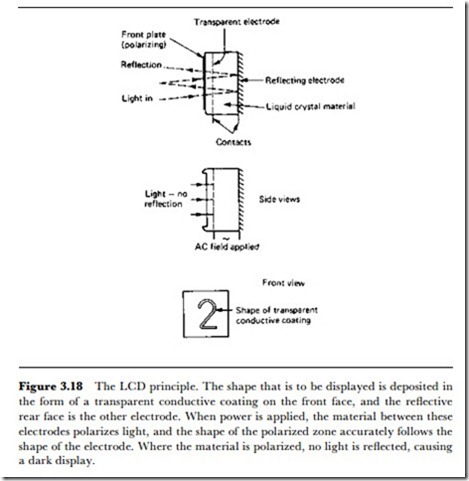Liquid crystal displays (LCD)
Liquid crystals are not necessarily liquids, and definitely not crystals, but the name has stuck and is considerably easier to remember than any more precise title. The name of liquid crystal was given to certain types of organic materials (chemicals found in living organisms) in the early part of this century because of their remarkable chemical structure. A crystal is an arrangement of atoms in which the precise order governs the behaviour of the material; it is hard, has a high melting point, and often polarizes light. Each atom in a solid crystalline material affects each of its immediate neighbours very strongly, and the materials are of comparatively simple chemical structure, often composed of just two types of atoms.
There are materials, however, in which some sort of order exists, but which are not crystals in the classic sense. These materials consist of units that contain hundreds of thousands of atoms, but there is enough interaction to arrange the units into a structure, particularly if the material is a viscous (thick) liquid. The units in such materials, one of which is cholesterol (the fatty material in the bloodstream), are in the form of long chains, and when these chains are arranged in line, the material polarizes light very strongly. The types of liquid crystal material which are of interest in electronics are those whose long chains can be aligned in an electrostatic field obtained by placing a voltage between two conductors. The liquid crystal materials are non-conductive, so that making the chains align in a field like this causes no current to flow. A liquid crystal display therefore consists of sets of electrodes with the liquid crystal material covering them, and with one transparent enclosing wall and a reflective backplate (Figure 3.18).
The liquid crystal display cell is used with a sheet of polarizing material over the transparent wall. External light will pass through the polarizing sheet, and if the liquid crystal material is not aligned, will pass also through this and be reflected from the back-plate. If a voltage is applied between two electrodes, however, the material between these electrodes will become polarizing, and the already polarized light will not pass and cannot be reflected. This makes the affected area look dark, and the stronger the illumination of the cell the greater the contrast between this dark area and the brighter parts that have not been polarized. Although some displays are made with a built-in backlight for viewing in the dark, LCDs generally are intended for use in well illuminated areas. The use of DC on the electrodes causes irreversible changes to the liquid crystal material, so that the usual practice is to invert the DC supply to low- frequency (30-60 Hz) AC and use this as the supply to the electrodes. The use of electronic conversion can ensure that no trace of DC is present, and since the power consumption is so low, relatively simple inverter circuits can be used.
Because the current requirement of the LCD is so low, of the order of 8 )lA for a four-digit display operating at 32 kHz, there is no problem about using battery operation, even when a complex driving IC is incorporated with the LCD. It is quite rare to find LCDs offered alone – practically every manufacturer supplies only the packaged units with inverters and driving logic built in. More recently, the ‘supertwist’ type of LCD has
become available, which offers much greater contrast along with faster operation, and this latter type is being used extensively for the screen displays of portable computers. The most recent development is the TFT screen, in which a set of thin-film transistors (TFT) controls each LCD cell of the screen. This allows fast-acting colour displays to be manufactured.
Other principles have been used, and are still used, for alphanumeric display. Filament displays, for example, can be obtained in seven-segment form, often with a better ratio of brightness to consumption than LEDs. Gas plasma displays, which were very common (in the form of the Ericsson Dekatron) prior to the emergence of LEDs, were used for some portable computer screens because they allowed viewing in poor illumination together with very low power consumption. The LED and LCD types, however, are by far the dominant types. Modern laptop computers use colour LCD displays in which each point on the screen is controlled by a thin-film transistor.
